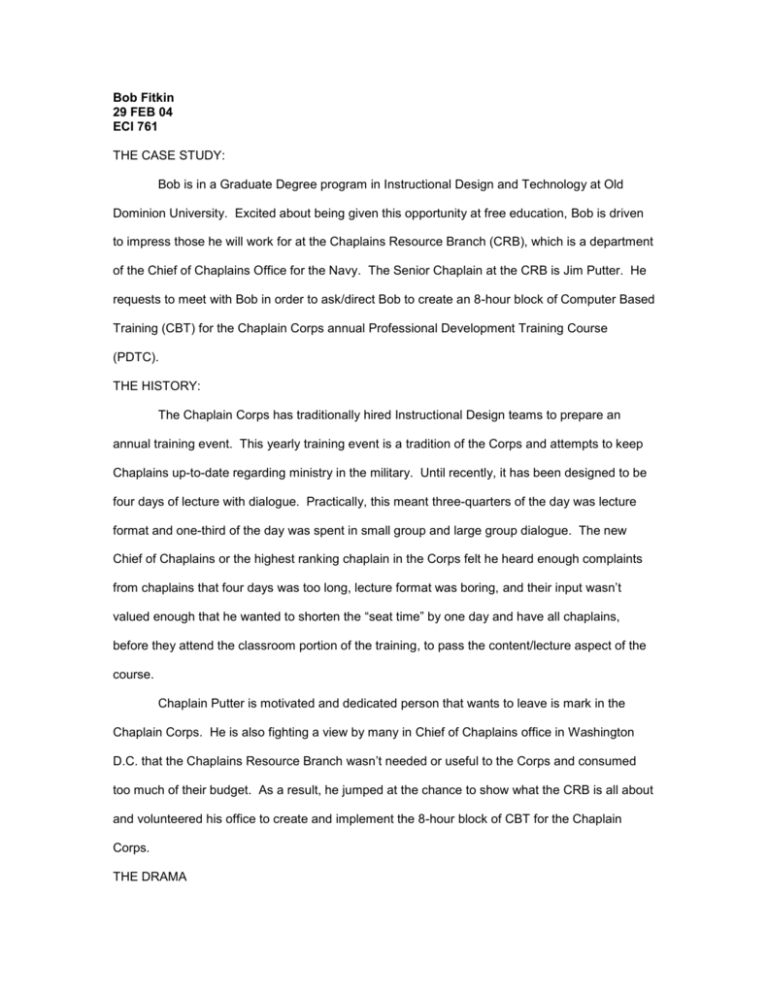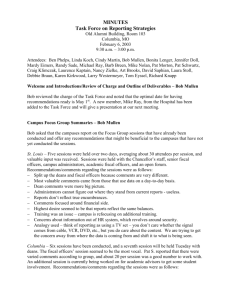Revised ver 3-2 - Old Dominion University
advertisement

Bob Fitkin 29 FEB 04 ECI 761 THE CASE STUDY: Bob is in a Graduate Degree program in Instructional Design and Technology at Old Dominion University. Excited about being given this opportunity at free education, Bob is driven to impress those he will work for at the Chaplains Resource Branch (CRB), which is a department of the Chief of Chaplains Office for the Navy. The Senior Chaplain at the CRB is Jim Putter. He requests to meet with Bob in order to ask/direct Bob to create an 8-hour block of Computer Based Training (CBT) for the Chaplain Corps annual Professional Development Training Course (PDTC). THE HISTORY: The Chaplain Corps has traditionally hired Instructional Design teams to prepare an annual training event. This yearly training event is a tradition of the Corps and attempts to keep Chaplains up-to-date regarding ministry in the military. Until recently, it has been designed to be four days of lecture with dialogue. Practically, this meant three-quarters of the day was lecture format and one-third of the day was spent in small group and large group dialogue. The new Chief of Chaplains or the highest ranking chaplain in the Corps felt he heard enough complaints from chaplains that four days was too long, lecture format was boring, and their input wasn’t valued enough that he wanted to shorten the “seat time” by one day and have all chaplains, before they attend the classroom portion of the training, to pass the content/lecture aspect of the course. Chaplain Putter is motivated and dedicated person that wants to leave is mark in the Chaplain Corps. He is also fighting a view by many in Chief of Chaplains office in Washington D.C. that the Chaplains Resource Branch wasn’t needed or useful to the Corps and consumed too much of their budget. As a result, he jumped at the chance to show what the CRB is all about and volunteered his office to create and implement the 8-hour block of CBT for the Chaplain Corps. THE DRAMA Bob walks into the morning and sits down along with Chaplain Putter and the rest of his staff to discuss the CBT project. As the meeting begins, he puts Bob at the end of the long table with him at the opposite end. Jim shares with his staff how important his successful completion of this program is and directs his current ID, Mike, to help Bob get through it without a hitch. Nevertheless, he reminds Bob, “If you fail, you understand that I will need to find another job for you out of this office.” Mike assures Bob he will help him navigate a two program in one year. Then Jim informs Bob he wants the computer based project designed in Macromedia Director to show the Chaplain Corps what can be accomplished with the proper tools. As Bob listens to Jim explain in further detail, Bob begins to worry and wonder because he has not used the software program before and asks, “How am I going to learn this program and complete the rest of the requirements before May graduation?” When Bob’s attention returns to the meeting, he agrees to do take on the project as directed/requested. Jim Putter is a driven man enthusiastic about technology and has volunteered his corporation to prepare an 8-hour block of Computer Based Training (CBT) for Navy Chaplains. The other chaplains that work for Jim Putter cringe every time he walks out of his office because he has too many ideas and not enough time to accomplish them, but it doesn’t keep him from trying, which means adding more and more the his staff that feels over worked and under paid. Jim calls Bob and asks him to use this as his project and says, “Bob, if you complete this successfully, you are assured of great reward. So study hard and make sure you keep me updated on your progress. This training will be the highlight of the military chaplaincy.” Bob wonders to himself, “I wonder if I don’t succeed?” Jim also assigns Bob to the Instructional Design team in Florida to work with those that will design the other 3-days of training for the Chaplain Corps. Jim Putter request Mike and Bob to fly down to the kick off meeting for the design and implementation of the 2005 PDTC. When they arrived in Florida for their meeting, the instructional design team that consisted of all with doctorates began to ask specific questions about the Computer Based Training aspect of the PDTC. Neither Mike nor Bob were able to answer specific questions about the CBT, but it was clear that the contracted instructional design team only wanted to know when it was going to be ready and how it was going to connect with their 3-days of classroom training. Tentative dates were set for February to re-exam the process. THE CURRENT SITUATION A progress meeting has been set by Chaplain Putter on 5 March 04 in order to discuss Bob’s progress with the CBT. Jim does not communicate this directly to Bob, but through the one Bob will replace, Mike Smith. Though, Jim does send a copy of the e-mail to Bob. Bob has also received copies of correspondence between Jon Frusti (the project manager between military and civilian personnel) and the civilian contracted design team that is preparing the other 3-days of training. Jon has requested a meeting in Norfolk VA at the Chaplains Resource Branch in order to work out any issues that have arisen since the PDTC 2005 kick off meeting that both Bob and Mike Smith attended along with all other parties involved. THE ISSUES During period of time between the kick off meeting last October 2003 and the meeting requested at the end of March 2004 each group has done its own thing with regards to the project. Then the civilian instructional design team sent a proposed outline for training that totaled 64 Enabling objects plus another page of URL sites to be included in the 8-hours of training. No answers were given, no direction, just information overload. Now Bob is worried that not only would they like him to produce the template for training, but also decide upon the content of training. What was a reasonable project for Bob has turned into a overwhelming fear-filled process to have it completed by the Summer 2004 in addition to graduation requirements from ODU. As a result of these feelings, Bob meets with Chaplain Putter to share his concerns with him. He is receptive, but wants me to correspond with the appropriate parties instead of him even though Bob asked him to do so because of Chaplain Putter’s higher ranking status in a Military Organization. Then the CRB staff informs Bob that this is Jim’s way of doing business, i.e. he won’t stand up for his people when it counts. While at the meeting, Bob request a special 8-hour block of training specifically about quizzes as he is not familiar enough with Director MX to do this without a great deal of extra time that he does not have in such a demanding course load required by the Navy to graduate sooner than later. Bob, worried about failure, speaks to his program advisor at ODU who is also a doctoral level instructional designer to gain insight as to what is reasonable and a direction to take from this point of confusion, dismay, and disappointment. Bob’s advisor suggest to choose his own Terminal Objective along with 3 enabling objectives in order to stay on target for graduation in May and to ask for specific answers to only 24 objectives that can reasonable be put into 8-hours of instruction via CBT. Bob wrote Jon Frusti requesting this information and Jon agreed and sent this request to the civilian ID team. The answer should have come this week, but no answer came. Bob wonders what he should do. The silence is raising his anxiety and making his life more miserable.







